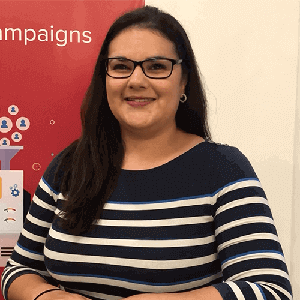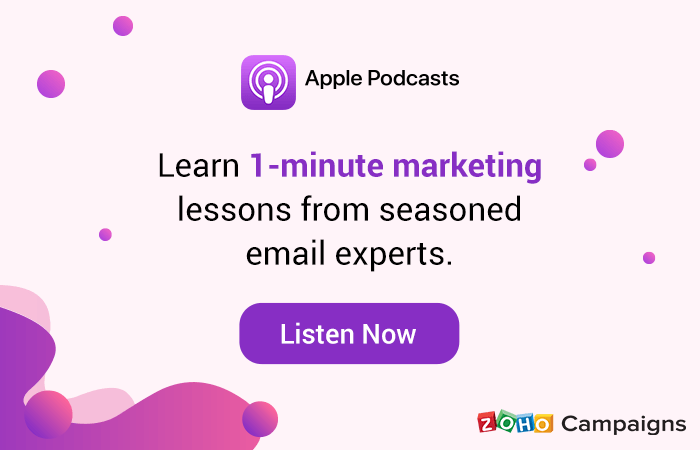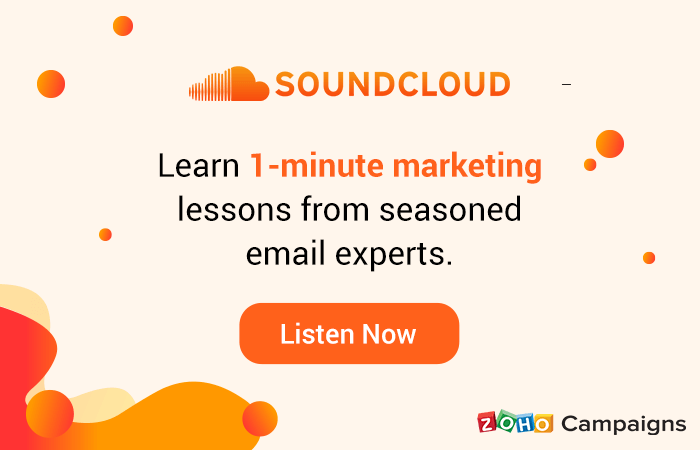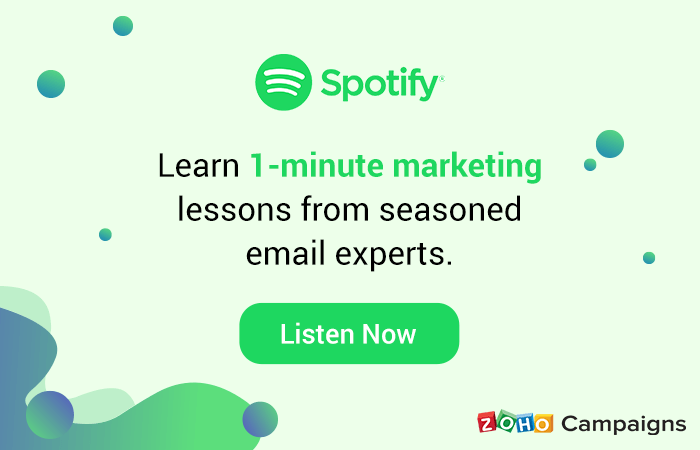1-Minute Marketing with Email Experts
With 1-Minute Marketing from Zoho Campaigns, learn email marketing the easy way with less-than-a-minute lessons, delivered directly by seasoned experts, and covering every concept from email creation to execution and deliverability.
Sign up for freeSteps for email newbies
- Takeaway
- Transcript
- Expert
- Begin with a plan.
- Decide who-when-what.
- Watch how many emails you send.
Describing how to do email or creating an email, in one minute, is tough. So, what I’d say is the one thing you need to have is—you need to have a plan. Who is going to get the email, when are they going to get it, how are you going to make sure they don’t get too many, what’s the content going to be—have a plan before you do anything else.

Skip Fidura is a customer-centric data marketing expert, keynote speaker, and technologist. He focuses on using technology to build real conversations with customers and loves putting complex concepts into plain actionable language. Skip also emphazises on responsible marketing in the age of AI, machine learning, and block chain, and speaks in top conferences about various email marketing topics.
- Create personalized email content.
- Use email intelligently.
- Understand data.
Creating the right personalized content is absolutely a gate to get an engagement from your subscribers. So how do you do it? You make sure you're using email intelligently, you understand the data, so you can send the right message to the right person at the right time.

Kate Barrett is the Founder and Director of eFocus Marketing, providing specialized email marketing training and consultancy. With 12 years of dedicated experience in email marketing, she's worked with several top brands like Nissan, Marks & Spencer, Adidas, M&M Direct, and more, increasing their results. Kate is also a three-time elected member of the DMA Email Council.
- Identify email needs that serve customers.
- Ask yourself 'why' you're sending emails.
- Understand the problems your emails solve.
Alright! So when you're thinking about creating empathetic emails for your brand you really have to think about the needs that your emails are serving for your customers rather than what needs they're serving for you. So the question I like to ask myself is why am I sending this email right now? And what problem is it going to solve for my customers?

Kait Creamer is the CRM Marketing Manager of Framer. She advocates the usage of empathy and emotional intelligence in email marketing. She's the recipient of the "Email Experience Council’s 2019 Stefan Pollard Email Marketer of the Year" award. A musician and artist herself, Kate has a great sense of combining creativity with logical data, constantly finding new avenues in email marketing to invest in.
- Choose good copywriting.
- Use relevant and quality imagery.
- Get this combination right to engage people.
Cool, so making emails interactive...Actually, I had this conference where someone did say something very interesting which is the best and simplest way to make interactive email is actually have content that people want to interact with. I think good copywriting and good imagery get people engaged. That's the best interaction you can hope for.

Elliot Ross is the CEO and Co-Founder of Taxi for Email, a brand that's passionate about improving the email production process. He's also the Managing Director at ActionRocket, a creative studio for email. Elliot has been in this space for more than 10 years, and as an email marketing professional himself, he resorts to making the email process a lot better, quicker, and easier.
- Don't neglect the basics
- Use simple methods like carousal and drop-downs.
- Spend time to investigate and understand their performance.
Yeah, with this one, with interactive emails being quite a complex thing, what I’d advise is actually try and look at what people are already doing. Start with something really basic. So, it might be a carousal or something, or something that really simple; it might be a drop-down menu, hamburger menu, or something like that. And, actually spend some time investigating and experimenting with it.
Don’t try anything you don’t know, quite anything on your own to begin with. Just try and find out how it works and what’s happening. And, then, plan and create project of your own, but start with a simple one, understand the process and the techniques required to make interactivity work. And, then, you can progress and actually think about “how can I make interactivity something that’s going to add value to an email?” Don’t just do it for its own sake but what’s actually going to give a great experience for somebody using that email, and that’s what I’d say to start with.

Paul Airy is an Email Designer and Developer, with a fondness for typography. He's the author of 'A Type of Email,' a book that talks about typography guidelines for HTML emails. Paul also strongly advocates the concept of accessibility in emails, and he's created the Accessibility Switcher™ that was incorporated first in his newsletter, Type E, later adapted by Litmus as well.
- Join email marketing networks.
- Learn from resources available online.
- As you start up, communities help achieve a lot.
Well, I would suggest to join networks. So, there are some fantastically sources out there like the 'Women of Email' or the 'Email Geeks.' This is where I started learning more about my coding, and so if someone is running a show on their own, this is where the best help would be received.

Annett Forcier is the Founder of EmailBoutique Digital Inc., crafting outstanding email experiences for people. She's an email and web development expert, and helps brands deliver well-performing campaigns. From creating email design catalogue to networking and providing email consulting—she dons all the roles, exceptionally.
- Watch out for multiple channels.
- Keep content relevancy in mind.
- Use techniques like segmentation and interactivity.
I think to build your target audience, probably stems from high interaction from the digital channels as well. To make it sure you’ve got the next right, there are strategies, so how let interact with your emails; with your AMP users for example, how to grow and maintain, rather how to maintain the database is obviously around relevancy.
So, segmentation, when the relevancy comes, how do you place the content to the users, what devices they use—all ties in nicely with the likes of responsiveness and accessibility.

Chris Marcantonio is the Head of Email Marketing at Verse Group. A digital marketer with more than 10 years of expertise, he's worked across multiple industries, and has a web development background, with a knack for aesthetic designs. He focuses on streamlining email processes, and believes in accessibility being the key for email campaigns.
- Don't batch and blast.
- Respect your customers.
- Do email properly.
So, the top thing not to do in email marketing is—don’t batch and blast. Everybody talks about having respect for your consumer, and obviously you should do that, but really, just have some respect for yourself. Do email properly.

Skip Fidura is a customer-centric data marketing expert, keynote speaker, and technologist. He focuses on using technology to build real conversations with customers and loves putting complex concepts into plain actionable language. Skip also emphazises on responsible marketing in the age of AI, machine learning, and block chain, and speaks in top conferences about various email marketing topics.
- People read email in different ways.
- Break longer email text into multiple headings.
- Give relevant links for each heading to engage deeper.
Typography really does play a part in subscribers’ reading style. This is because some people just prefer to scan through an email, and some people actually like to read an email in more depth. So a good practice is to actually break up text within an email with headings, and use the headings to convey the message in simple terms so that even just reading the headings will convey what the email is about.
And then, following it up with the call-to-action that makes sense according to those headings, and then with the text that gives more value to the copy and helps somebody to dig a bit deeper to really understand and engage with the full content.

Paul Airy is an Email Designer and Developer, with a fondness for typography. He's the author of 'A Type of Email,' a book that talks about typography guidelines for HTML emails. Paul also strongly advocates the concept of accessibility in emails, and he's created the Accessibility Switcher™ that was incorporated first in his newsletter, Type E, later adapted by Litmus as well.
- Emotional intelligence and data are connected.
- Data removes ambiguity and subjectivity.
- Emotional beliefs and data give proof for conversations.
A lot of people think that emotional intelligence and data are really disparate concepts, because it's kind of like right brain–left brain theory. But, I think emotional intelligence and data in marketing work really nicely together—because data takes all ambiguity out of the conversation, data can make previously contentious conversations really easy to have, so talking with your internal peers about, "Okay, well, the data is telling us that we need to do this thing." So, it makes it a lot easier to take opinion and subjectivity out your question.

Kait Creamer is the CRM Marketing Manager of Framer. She advocates the usage of empathy and emotional intelligence in email marketing. She's the recipient of the "Email Experience Council’s 2019 Stefan Pollard Email Marketer of the Year" award. A musician and artist herself, Kate has a great sense of combining creativity with logical data, constantly finding new avenues in email marketing to invest in.
- A sneak-peek into hand-coding.
- What fluid-hybrid technique is all about.
- Responsiveness of emails across multiple clients.
Well, I actually hand code all my templates because I find that templates out there are not providing enough responsive behavior across the email clients. So, I code with the fluid-hybrid approach that will allow emails on Gmail to stack and behave responsively.

Annett Forcier is the Founder of EmailBoutique Digital Inc., crafting outstanding email experiences for people. She's an email and web development expert, and helps brands deliver well-performing campaigns. From creating email design catalogue to networking and providing email consulting—she dons all the roles, exceptionally.
- Engage wide range of people.
- Multiple devices used by the audience for reading.
- The audience might have different cognitive and physical conditions.
Accessibility is the key for email marketing! Devices change everyday, we need to access a wide range of people, to be covering some of them stressed from what they might have as a disease they might be epileptic, they might be dyslexic. So, we need to make sure that everyone from the wide range in forms of what not and what devices they have to read our content. It's vitally important for the future.

Chris Marcantonio is the Head of Email Marketing at Verse Group. A digital marketer with more than 10 years of expertise, he's worked across multiple industries, and has a web development background, with a knack for aesthetic designs. He focuses on streamlining email processes, and believes in accessibility being the key for email campaigns.
- Double-check your email content.
- Embed your CTA links carefully.
- Start emails from scratch rather than cloning.
The things that can go wrong when you make an email so, you get the wrong content and you get the wrong links. So, ways to avoid that or ways people commonly get that wrong is that they take last week's email they clone that over, and then they make a new email. So, a better way is to start from scratch each time therefore you know you've got to change everything before you send it.

Elliot Ross is the CEO and Co-Founder of Taxi for Email, a brand that's passionate about improving the email production process. He's also the Managing Director at ActionRocket, a creative studio for email. Elliot has been in this space for more than 10 years, and as an email marketing professional himself, he resorts to making the email process a lot better, quicker, and easier.
- Ensure your links work in the emails.
- Check if images render correctly.
- Do testing for different email clients.
Some technique to ensure the quality of the emails before you send them include going through and actually making sure all your links work, your images render correctly, doing testing in different email clients to make sure that your design looks as it should do in different email clients and just generally giving everything a once-over, before you press the send button.

Kate Barrett is the Founder and Director of eFocus Marketing, providing specialized email marketing training and consultancy. With 12 years of dedicated experience in email marketing, she's worked with several top brands like Nissan, Marks & Spencer, Adidas, M&M Direct, and more, increasing their results. Kate is also a three-time elected member of the DMA Email Council.
- Importance of email testing.
- Check across different live devices.
- Understand what works before sending emails.
Testing, testing, testing! I test my email work on live devices. I have a little bit of live devices to help, and I use Litmus a tool in order to cross-test all my emails across the platforms.

Annett Forcier is the Founder of EmailBoutique Digital Inc., crafting outstanding email experiences for people. She's an email and web development expert, and helps brands deliver well-performing campaigns. From creating email design catalogue to networking and providing email consulting—she dons all the roles, exceptionally.
- Make email text larger.
- Optimize content for mobile phones.
- Employ HTML text for people using screen-readers.
Alright, this is quite a really easy one. Essentially, make your text larger—16px size is what I’d set minimum. I also recommend 18px for text on a mobile phone, the reason being that the high definition displays that we have nowadays actually decrease the visual size of the text. So, it’s compensated by using 18px—makes that text a little bit larger, so that essentially is a really easy way to help visually-impaired people.
In terms of screen readers as well, having an HTML text rather than text and images will help people who’ve text read out to them from an email, and will solve the problem for a lot of people.

Paul Airy is an Email Designer and Developer, with a fondness for typography. He's the author of 'A Type of Email,' a book that talks about typography guidelines for HTML emails. Paul also strongly advocates the concept of accessibility in emails, and he's created the Accessibility Switcher™ that was incorporated first in his newsletter, Type E, later adapted by Litmus as well.
- Maximize positive engagement with campaigns.
- Easier to get email marketing right than fixed.
- Messaging should specify what customers really want from you.
When you're thinking about email deliverability, it's a big subject, but if you're just getting started, the main elements that I suggest you focus on is really maximizing the positive engagement with your campaigns. So, it's a lot easier to get email marketing right than it's to fix it.
So, focus on positive engagement, minimize negative engagement, and really think about what your customers want from you, and how can you deliver it in your messaging.

Kate Barrett is the Founder and Director of eFocus Marketing, providing specialized email marketing training and consultancy. With 12 years of dedicated experience in email marketing, she's worked with several top brands like Nissan, Marks & Spencer, Adidas, M&M Direct, and more, increasing their results. Kate is also a three-time elected member of the DMA Email Council.
- Track opens, clicks, and conversions.
- See what lessons you've learned from metrics.
- Don't base your actions entirely on numbers and data.
So, things to track when you're making an email...hmm, we can track everything; we can track opens, clicks, engagement. We can have a look at conversions, and stuff. That's great! Tracking as much as possible is very important. The thing I'd say is what lessons you learn from it. Don't take the numbers as Gospel. Read into them, see what is actually true, what isn't actually true. Don't just base decisions very actively on these numbers; think about what they mean and then base a strategy on that.

Elliot Ross is the CEO and Co-Founder of Taxi for Email, a brand that's passionate about improving the email production process. He's also the Managing Director at ActionRocket, a creative studio for email. Elliot has been in this space for more than 10 years, and as an email marketing professional himself, he resorts to making the email process a lot better, quicker, and easier.
- Have an eye on conversions.
- Email engagement based reviews.
- Email delivery check and how to maintain it.
The metrics I advise on—the key metrics I advise on are conversion rates—obviously, that's ultimately telling what your emails are producing/selling. If you move to focus on engagement, I think ultimately an important one by delivery is backtracks. So, if your backtracks are quite high, there's something wrong with your data, which really and adversely affects your delivery.

Chris Marcantonio is the Head of Email Marketing at Verse Group. A digital marketer with more than 10 years of expertise, he's worked across multiple industries, and has a web development background, with a knack for aesthetic designs. He focuses on streamlining email processes, and believes in accessibility being the key for email campaigns.
- Set up recommended workflows to boost conversations.
- Send series of emails not just a one-off.
- Ensure the email content is actionable.
If you're just getting started with email marketing, the email automation workflows that I recommend you look at to boost conversions are your welcome and onboarding program to drive your first purchases, and your abandoned basket emails to drive people who have almost gone through the process, but haven't quite got there yet. And, don't forget—send series of email, not just a one-off to make sure that you can deliver the information that's right for them, to encourage them to take that action.

Kate Barrett is the Founder and Director of eFocus Marketing, providing specialized email marketing training and consultancy. With 12 years of dedicated experience in email marketing, she's worked with several top brands like Nissan, Marks & Spencer, Adidas, M&M Direct, and more, increasing their results. Kate is also a three-time elected member of the DMA Email Council.
- Ensure design looks good.
- Make your emails more useful.
- (Pretty + Useful) emails > (Pretty + boring) emails.
So, I get asked a lot how to design emails for better customer retention. And the answer is—there’s a design thing; if your emails are ugly, nobody’s going to look at them, and you’re not going to retain customers. But, if your emails aren’t useful, then you’re not going to retain consumers. It’s more important for your emails to be useful than is pretty, as more important for them to be pretty and boring.

Skip Fidura is a customer-centric data marketing expert, keynote speaker, and technologist. He focuses on using technology to build real conversations with customers and loves putting complex concepts into plain actionable language. Skip also emphazises on responsible marketing in the age of AI, machine learning, and block chain, and speaks in top conferences about various email marketing topics.
- Knowing typography 'widows' in emails.
- Use of non-breaking space to combat widows.
- Weighing design options based on the word length.
Okay, yeah, there are quite a few hacks. One of my favourite ones is the one to solve the problem of using widows in text. Widow is basically when you have a single word on the last line of a paragraph, and in typography terms, that’s a bad thing. And, you can fix that by putting what’s called a non-breaking space between the last word of the paragraph and the word before it, which effectively joins them together and avoids this widowing.
And, this non-breaking space is which you put in between. You do have to be careful about this because if you go wrong with which is before the last word, you join those together, you have quite awkward spacing. So, you have to weigh up what the best option is in terms of design, look at it in context, and make it as one. So, yeah, this is one of the best ones I found and used it quite often.

Paul Airy is an Email Designer and Developer, with a fondness for typography. He's the author of 'A Type of Email,' a book that talks about typography guidelines for HTML emails. Paul also strongly advocates the concept of accessibility in emails, and he's created the Accessibility Switcher™ that was incorporated first in his newsletter, Type E, later adapted by Litmus as well.
- Structure of a good email template.
- Accessing calls-to-actions in emails.
- Scrolling in emails while the recipients read.
By making it easy for users to access the call-to-action early in the email, I believe, if you wrote a neat headline, a good short explanation, and a call-to-action—for users that like to scroll and need more information, I would repeat that call-to-action in the bottom of the email so I don't make them scroll up again.

Annett Forcier is the Founder of EmailBoutique Digital Inc., crafting outstanding email experiences for people. She's an email and web development expert, and helps brands deliver well-performing campaigns. From creating email design catalogue to networking and providing email consulting—she dons all the roles, exceptionally.
- Inclusive (and not impulsive) email marketing.
- How AI helps in building conversations with people.
- Usage of positive language in emails.
As someone who is not a city girl myself, I have an analogy for this that I think makes a lot of sense. To me, the experience of achieving 'Email Marketing Zen' feels much like sitting down in a quiet dinner party with friends. And, historic marketing has been more like forcing someone to walk through the Times Square against their will, the taxis coming at them, there are ads everywhere—it feels very overwhelming!
And I think AI has really enabled us to be more thoughtful about when we talk to people, the ways in which we do talk to them, and I think that conveys more of that dinner party, creating-relationships feeling than just throwing things at people.

Kait Creamer is the CRM Marketing Manager of Framer. She advocates the usage of empathy and emotional intelligence in email marketing. She's the recipient of the "Email Experience Council’s 2019 Stefan Pollard Email Marketer of the Year" award. A musician and artist herself, Kate has a great sense of combining creativity with logical data, constantly finding new avenues in email marketing to invest in.
- Responsiveness is the key.
- Responsivess and accessibility are tied.
- People need to understand what you send them.
I guess going forward, responsiveness is something that can never really change. I mean…it’s a way of future-proofing something, you know, if you’re viewing something on smart watch or from a mobile device—it’s something that’s always going to be responsive. It ties in nicely with accessibility as well, so it’s something that’s constantly is there.

Chris Marcantonio is the Head of Email Marketing at Verse Group. A digital marketer with more than 10 years of expertise, he's worked across multiple industries, and has a web development background, with a knack for aesthetic designs. He focuses on streamlining email processes, and believes in accessibility being the key for email campaigns.
- Regulations do good to emails.
- GDPR covers email best practices.
- Don't fear regulations and laws.
So, the reason we have all those regulations in email industry is because of the emailers themselves. If we do email properly, the regulation doesn’t matter. There’s nothing in GDPR that wasn’t a best practice long before the GDPR was ever heard of. Do the email right, have respect for yourself, make the decisions, and regulations won’t be a problem.

Skip Fidura is a customer-centric data marketing expert, keynote speaker, and technologist. He focuses on using technology to build real conversations with customers and loves putting complex concepts into plain actionable language. Skip also emphazises on responsible marketing in the age of AI, machine learning, and block chain, and speaks in top conferences about various email marketing topics.
- Don't assume the recipients' interests.
- Handling of single opt-in and double opt-in.
- Different emails involving recipient interaction.
So, emails have evolved since GDPR and we had to evolve. All the email tactics—you’ve got things like opt-in, double opt-ins; we can’t just assume someone wants to hear from us. A great example for us is how booking confirmation emails, we can’t put any direct marketing messages in there. Everything has to be so functional in those emails, so we really need to be careful on the content and the words we use in our messaging.

Chris Marcantonio is the Head of Email Marketing at Verse Group. A digital marketer with more than 10 years of expertise, he's worked across multiple industries, and has a web development background, with a knack for aesthetic designs. He focuses on streamlining email processes, and believes in accessibility being the key for email campaigns.
- Artificial intelligence to understand human emotions.
- Significance of real-time data over historical data.
- Usage of positive language in emails.
So, technology has proven a lot of our previous beliefs wrong in recent years. And I think a really cool example of that is how Phrasee is using AI to show that humans react to all sorts of different emotions and subject lines. I think historic knowledge or conventional knowledge has told us that people react to things with a lot of exclamation points, or you know, 60% off, and things like that.
So, historically marketers have been using a lot of fear tactics in their subject lines to motivate people to do the right thing, and I think AI is showing us that really we're more effective when we use language that is positive and helpful, and motivates people to be the best versions of themselves, rather than just to dump all their money on you.

Kait Creamer is the CRM Marketing Manager of Framer. She advocates the usage of empathy and emotional intelligence in email marketing. She's the recipient of the "Email Experience Council’s 2019 Stefan Pollard Email Marketer of the Year" award. A musician and artist herself, Kate has a great sense of combining creativity with logical data, constantly finding new avenues in email marketing to invest in.
- Use of illustrations in emails.
- Showing animated GIFs in relevant sections.
- Finding purpose and conveying the message with image-text balance.
Seeing the future trends, in terms of visual things recently, no so much accessibility things or typography things, but the use of illustrations in emails is a trend that’s growing really nice where it’s giving some personality to emails.
Using animations (animated GIFs), but using those with purpose is really important as well to kind of convey the message of the email rather than just having a kind of fancy or gimmick-y. Yeah, those use of images is something that email marketers can really use to enhance the messaging of their email.

Paul Airy is an Email Designer and Developer, with a fondness for typography. He's the author of 'A Type of Email,' a book that talks about typography guidelines for HTML emails. Paul also strongly advocates the concept of accessibility in emails, and he's created the Accessibility Switcher™ that was incorporated first in his newsletter, Type E, later adapted by Litmus as well.
- Creativity plays an important role in marketing.
- More flexibility and improvization.
- Willingness to take risks.
So, I'm an artist and musician.That's why I have kind of creative background, and I find that plays an important role in my marketing, and that enforces me to think a little more flexibly about how we're doing things. I don't have any of that historical background of necessarily what always works in the past, because I come from a background where you get up on stage and you improvize.
And, so, I think that plays a role in that. I'm willing to take some risks and be a little more playful with my marketing, because I know that's just rewarding from a human perspective, when people see something that's still like for creative or artistic in one way or another—it kind of, you get like a little spark, but you don't necessarily see with regular advertising. So it's something that I try to keep in my mind before I work on my marketing.

Kait Creamer is the CRM Marketing Manager of Framer. She advocates the usage of empathy and emotional intelligence in email marketing. She's the recipient of the "Email Experience Council’s 2019 Stefan Pollard Email Marketer of the Year" award. A musician and artist herself, Kate has a great sense of combining creativity with logical data, constantly finding new avenues in email marketing to invest in.
- Ensure data is accurate.
- Use email tools as much as possible.
- Consistent usage of the software influences data quality.
Yes, it's absolutely true! You know the software that you use is only half as good as the data that you put in; and, also, the accuracy of that data once it's in there. So, it's vitally important to make sure that the data you have is as accurate as possible. The way you do that is just to use the tools as much as possible, so that becomes the single source of truth for your data. And then that means that because you're using it all the time, you know that the right data is in your tool.

Elliot Ross is the CEO and Co-Founder of Taxi for Email, a brand that's passionate about improving the email production process. He's also the Managing Director at ActionRocket, a creative studio for email. Elliot has been in this space for more than 10 years, and as an email marketing professional himself, he resorts to making the email process a lot better, quicker, and easier.
- Usage of specific UTM text.
- Call-to-action positions in emails.
- Tracking the clicks for all the calls-to-action.
For example, you could use some more specific UTM text on the CTA button I just mentioned—that one on the top and one on the bottom, and find out if more users actually click further down the email or further up, so that would give us more information about preferred positions for calls-to-action.

Annett Forcier is the Founder of EmailBoutique Digital Inc., crafting outstanding email experiences for people. She's an email and web development expert, and helps brands deliver well-performing campaigns. From creating email design catalogue to networking and providing email consulting—she dons all the roles, exceptionally.
Beginner Zone
- Steps for email newbies
- Personalized content for email engagement
- Empathetic emails for your brand
- Simple ways for interactive emails
- Interactive email designs
- Email design for non-coding marketers
- Build and grow your email audience
- Not-to-do in email marketing
Personalization & Inclusion
- Email typography and reading style
- Role of emotional intelligence and data in emails
- The 'human' quotient in automated emails
- Accessibility—a key to email marketing
Optimization & Deliverability
- Things that go wrong in emails
- Easy techniques for email testing
- Designing emails for the mobile audience
- Email accessibility for disabled readers
- Email deliverability practices for newbies
- Parameters to optimize email campaigns
- The most-important email metrics
Useful Tips & Hacks
- The most-used email workflows
- Emails for customer retention
- The best email typography hacks
- Emotional intelligence for email designs
- All about 'Zen' in email marketing
- What doesn't change in email marketing
Privacy Regulations
- The age of email privacy regulations
- Email marketing post GDPR
Trends & Thoughts
- Email myth proven wrong
- Email design trends of 2019
- Creativity influencing emails
- Email software as good as data
- Optimizing design in future emails










